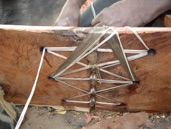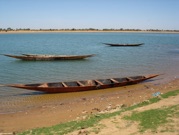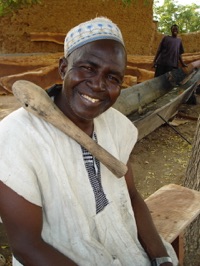Traditional bozo boat builders
By Elisabeth den Otter
Kaka and his sons Aruna and Abba are builders of traditional boats ('pirogues'). They belong to the Bozo ethnic group and live in the village of Kirango, on the shore of the Niger river near the (in)famous Markala dam. Kaka's father came from a traditional Bozo village to Kirango 35 years ago to build boats for the local fishermen. The family still speaks Bozo at home.
In 2006 I filmed the construction of a new boat and the repairing of an old boat, which resulted in the DVD "'Kurundilana' (constructeurs de pirogues)", (35 minutes, Samaké Records 04, 2007). The new boat measures 8 meters and can carry 700 kg or 9 persons.
The boats are of the type 'sewn boat' ('pirogues cousues') and are from 7-20 meters long.
The wood used is caïlcédrat (acajou of Senegal), 'nguala' in bamanan language.
Instruments used are: various types of hoe, piercer, hammer, file, saw, pincers, and hand drill.
Traditionally, measures are calculated with the body of the builder: underarm + hand for the length and foot for the width of the bottom. The shape of the bottom is then marked off with string, after which a piece of charcoal is used to draw the definite shape so that the remaining wood can be cut off.
The planks are shaped by means of burning wood shavings on top or underneath them, putting weights on the top of them to weigh them down, and putting supports under them to push them up.
The bottom is made from two big planks that are joined laterally by cutting overlapping profiles into the edges. One profile is then blackened with water mixed with ashes, which leaves an impression of uneven spots on the other profile so that the excess wood can be shaved off.
After that the joint is caulked by applying a paste made of baobab powder mixed with water, and covering it with rags. Two rows of holes are drilled with a hand drill, after which nails are driven into them.
The sides are built up by means of four side planks, two for each side, which are joined together. First, holes are drilled near the edge of the planks by means of hot iron staves, after which they are 'sewn' together with nylon chord. Wet jute is used to 'waterproof' the holes and the gap between the planks.
The stem and the stern are made out of separate pieces of wood and attached to the bottom planks.
A man standing on a platform near the stern pushes the boat with a bamboo pole in shallow water; in deeper water paddles are used.
Literature
Hagemann, A. (1983)
'Bootsbau in Mali', in Baessler-Archiv, Neue Folge, Band XXXI, p.57-135
Kassibo, B. and J.Brunet-Jailly (2003)
'La pirogue, monture du bozo, hier et aujourd'hui', in: Djenne Patrimoine Informations, numéro 14
➤Home




